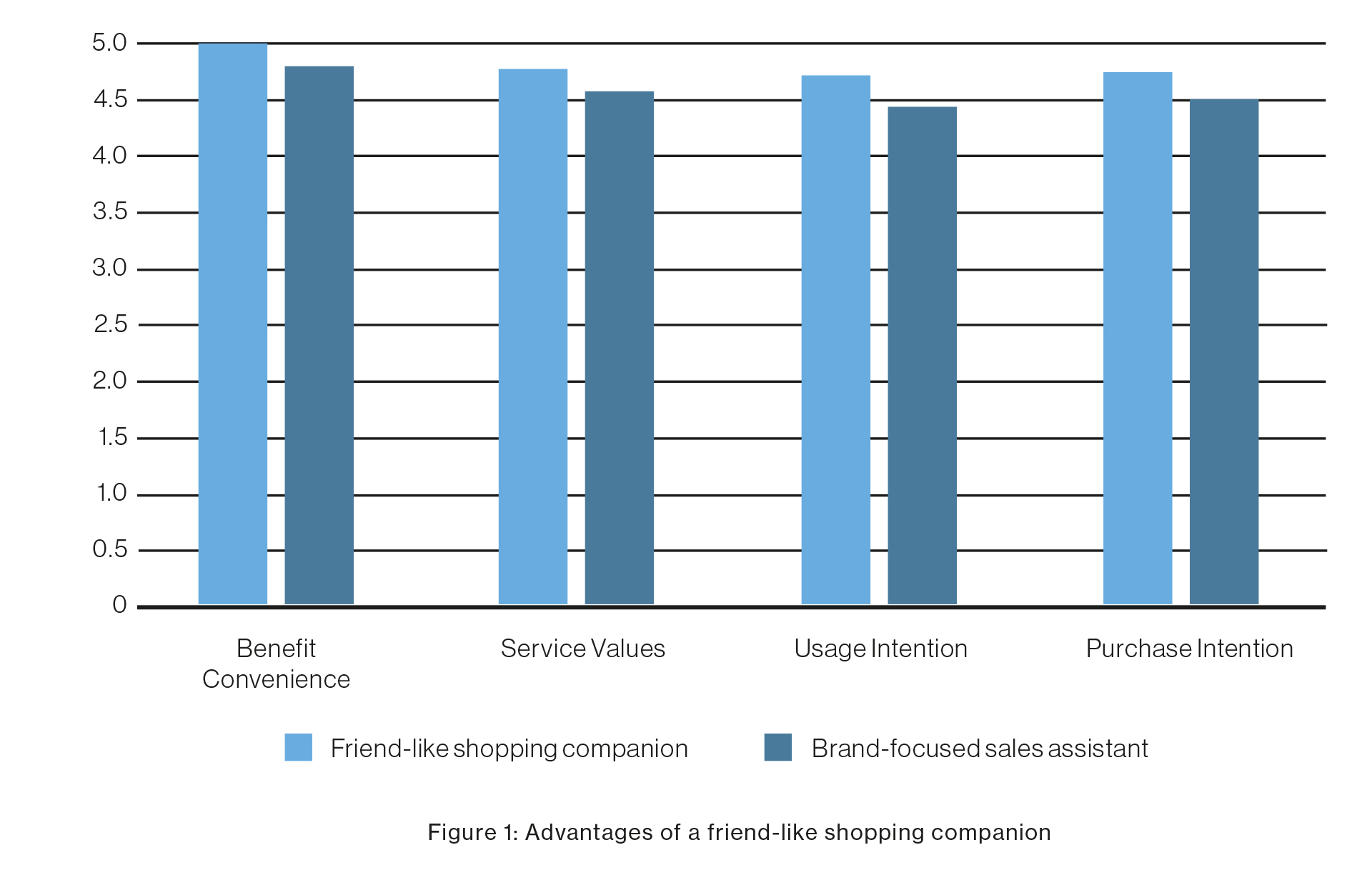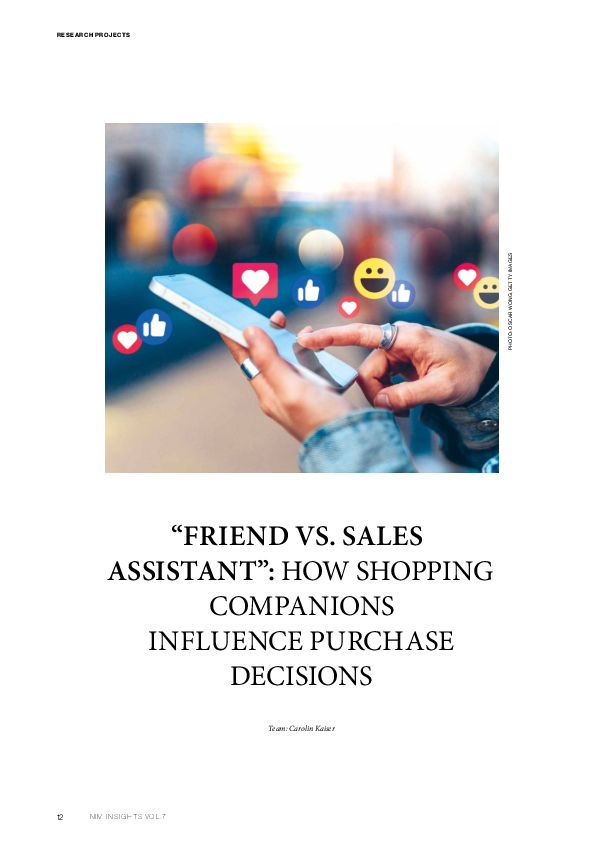Forschung
Friend vs. Sales Assistant

PHOTO: OSCAR WONG, GETTY IMAGES
Imagine two virtual e-commerce chatbots: One acts like a close friend who prioritizes your needs; another be- haves like a sales assistant from a certain brand. A new study by the University of Braunschweig and the Nuremberg Institute for Market Decisions shows that friend-like chatbots, so-called “shopping companions,” significantly increase customers’ perceived value of the service interaction and overall purchase intentions.
Chatbots are becoming a staple many chatbots simply guide customers through purchase steps without building deeper trust or connection. To more fully understand chatbots and consumers’ response to them, researchers from the University of Braunschweig and the Nuremberg Insti- tute for Market Decisions investigated whether a “friend” role, rather than a “sales assistant” role, would lead to higher interactive value—the overall value users derive from engaging with a service provider.
This “value in interaction” can be under- stood through three layers:
- Relationship Layer: Evaluates the depth of connection and trust users feel toward the chatbot.
- Matching Layer: Assesses how well the chatbot helps users find suitable products or services based on their preferences.
- Service Layer: Measures the overall quality and usefulness of the chatbot’s assistance during the interaction.
The central questions concerned whether friend-like communication cues (e.g., supportive language and a neutral personal avatar) would raise these value dimensions more than a typical, brand-serving sales assistant approach and whether these cues also impact behavioral outcomes like purchase decisions and chatbot usage intentions.

Experiment of Chatbot Roles
A thousand participants from Germany (average age ~49, almost evenly split by gender) were randomly assigned to one of two chatbot conditions. Both ver- sions offered identical product infor- mation about a raincoat but differed in social cues.
Friend-Like Shopping Companion (n = 500)
Presented itself as a user-centric friend focused on the participant’s interests.
Emphasized matching the user’s price and color preferences without pushing for a sale.
Featured a neutral, friendly avatar and addressed the user in a supportive, casual manner, highlighting personal relationship and friendship cues.
Brand-Focused Sales Assistant (n = 500)
Framed itself as a store representative from the fictive store “Outdoor Retailers.”
Used subtle scarcity tactics (“limited stock”) and brandoriented prompts to enforce a purchase.
Showed an older-aged, more formal avatar dressed in a store uniform and used language reminiscent of a typical retail setting.
After viewing a brief video of their assigned chatbot’s simulated dialogue, participants evaluated each of the three value-in-interaction layers—relationship, matching, and service—along with behavioral outcomes such as usage intention, purchase intention (raincoat), and willingness to pay for the chatbot itself.
MAIN RESULTS
- The study found that when a chatbot adopts a friend-like persona rather than acting as a brand-focused sales assistant, it enhances the overall perceived value of the interaction, thereby influencing purchase intentions. In terms of relationship-building, the friend-like chatbot scored slightly higher, though not at a statistically significant level. This result indicates that both chatbot styles were equally effective in fostering user connections. Regarding the matching layer, which evaluates how well the chatbot helps users align their needs with available products, the friend-like chatbot demonstrated a clear advantage: Participants found it significantly more convenient to use. The service layer also favored the friend-like chatbot, with users rating its service value significantly higher compared to the sales assistant, reinforcing the idea that a more personable and customer-centric approach contributes to a more positive shopping experience.
- Critically, these perceived benefits translated into behavioral differences. Participants who interacted with the friend-like chatbot were more inclined to continue using it, showed higher purchase intentions for the raincoat, and expressed a slightly greater willingness to pay for chatbot-assisted services. Although most users were reluctant to pay for a chatbot in general, the friend-oriented design made them more open to the idea compared to the sales-focused assistant. Figure 1 shows the main advantages of a friend-like chatbot compared to a brand-focused assistant on a 7-point Likert scale.
KEY INSIGHTS
- This study highlights how the way chatbots communicate can significantly influence consumers’ perceived convenience, service value, and purchase decisions. The results suggest that adopting a friend-like, user-centered approach can create a more engaging and effective shopping experience. These insights are particularly relevant for businesses aiming to refine their digital strategies, consumers seeking more intuitive and stress-free interactions, and society as AI-driven communication becomes increasingly integrated into everyday life.
- For marketing managers, the findings of this study underscore the importance of designing AI-driven chatbots that prioritize customer support over direct sales tactics. Consumers responded more positively to chatbots that acted as friendly companions rather than brand-focused sales assistants, demonstrating that a user-first approach can enhance both engagement and purchase intent. Instead of relying on traditional persuasion techniques such as urgency and scarcity, marketers should focus on fostering trust and cooperation through AI interactions. By striking the right balance between persuasion and support, brands can build stronger, long-term relationships with their customers.
- For consumers, friend-like chatbots offer more intuitive and user-friendly shopping experiences. These chatbots make online shopping smoother by understanding individual preferences and offering tailored recommendations without exerting sales pressure. Unlike traditional e-commerce strategies that often push urgency and scarcity, a more cooperative chatbot approach gives consumers greater control over their purchase decisions.
- For society, the growing acceptance of friend-like AI chatbots raises important considerations for ethical AI development and the future of human-AI interactions. As consumers treat these digital assistants more like social entities, developers and policymakers must ensure that chatbots are designed transparently, avoiding manipulative sales tactics that exploit human trust. Beyond e-commerce, the success of humanlike AI interactions suggests that similar systems could play a meaningful role in other sectors, such as health care, education, and customer service.
Projektteam
- Dr. Carolin Kaiser, Head of Artificial Intelligence, NIM, carolin.kaiser@nim.org
Kooperationspartner
- Prof. Dr. Susanne Robra-Bissantz, Technische Universität Braunschweig
- Bijan Khosrawi-Rad, Technische Universität Braunschweig
Kontakt

